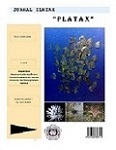Length-weight Relationship and Reproduction of Halfbeak Hemiramphus lutkei Valenciennes, 1847 In The Waters Around Nain Island, North Minahasa Regency
DOI:
https://doi.org/10.35800/jip.v11i1.44031Keywords:
Length-weight;, growth patterns;, gonad;, fekundity;Abstract
Abstract
The waters around Nain Island have quite a lot of biological resources. One of the resources in these waters is the halfbeak Hemiramphus lutkei. This study aims to determine the relationship between length-weight and reproduction of the halfbeak Hemiramphus lutkei. The length-weight relationship, growth patterns and condition factors. Reproduction includes sex ratio, gonadal maturity level, gonadal maturity index and fecundity. Fish sampling were taken from the catches of fishermen. The number of samples required is 200, the samples are taken twice in two months from June-July. The length-weight relationship of male was W= 0.1705L1.8204 negative allometric growth pattern and female fish W = 0.0572L2.1962 negative allometric growth pattern. The condition factor of male and female where 0.98 ± 0.06 and 1.03 ± 0.07 respectively. The sex ratio of male and female (1: 0.835). The gonad maturity level of male (immature, developing, mature, ripe and spent) was found in June and female (immature, developing, mature, ripe and spent) found in June and July. The fecundity of ranged from 923 – 3,578 eggs with an average of 1,899 ± 666.
Keywords: Length-weight, growth patterns, gonad, fekundity
ABSTRAKPerairan Sekitar Pulau Nain ialah perairan yang memiliki cukup banyak sumberdaya hayatinya. Salah satu sumberdaya yang berada di perairan tersebut yaitu, ikan julungjulung Hemiramphus lutkei. Penelitian ini bertujuan untuk mengetahui hubungan panjang-berat dan reproduksi ikan julungjulung Hemiramphus lutkei. Hubungan panjang-berat meliputi pola pertumbuhan dan faktor kondisi. Reproduksi meliputi rasio kelamin, tingkat kematangan gonad, indeks kematangan gonad dan fekunditas. Lokasi pengambilan sampel ikan diambil di perairan sekitar Pulau Nain dan sampel diambil dari hasil tangkapan nelayan. Jumlah sampel yang diperlukan sebanyak 200 ekor, sampel diambil sebanyak dua kali dalam dua bulan dari Juni-Juli. Hubungan panjang-berat ikan julungjulung jantan yaitu W= 0,1705L1,8204 pola pertumbuhan allometrik negatif. Ikan julungjulung betina W = 0,0572L2,1962 pola pertumbuhan allometrik negatif. Faktor kondisi ikan julungjulung jantan dan betina bernilai 0,98 ± 0,06 dan 1,03 ± 0,07. Rasio kelamin ikan julungjulung jantan dan betina (1:0,835). Tingkat kematangan gonad ikan julungjulung jantan (I, II, III, IV dan V) ditemukan pada setiap bulan Juni. Tingkat kematangan gonad ikan julungjulung betina (I, II, III, IV dan V) ditemukan pada setiap sampel pada bulan Juni maupun Juli. Fekunditas ikan julungjulung berkisar antara 923 – 3.578 butir dengan rata-rata 1.899 ± 666.
Kata Kunci: Panjang-berat, pola pertumbuhan, gonad, fekunditasReferences
Balukh, R., N.P. Rahardjo dan M. Maulita. (2021). Aspek Biologi Ikan Julungjulung Hemiramphus lutkei Di Pulau Rote, Nusa Tenggara Timur. Buletin Jalanidhitah Sarva Jivitam, 2(2), 57-68.
Collette, B.B., 1999. Hemiramphidae. Halfbeaks. p. 2180-2196. In K.E. Carpenter and V. Niem (eds.) FAO species identification guide for fishery purposes. The living marine resources of the Western Central Pacific. Vol. 4. Bony fishes part 2 (Mugilidae to Carangidae). FAO, Rome.
Effendie, M. I. (1979). Metode Biologi Perikanan. Yayasan Dewi Sri. Bogor
Effendie, M. I. (2002). Biologi Perikanan. Yayasan Pustaka Nusatama. Yogyakarta
Le Cren E. D. (1951). The Length-Weight Relationship and Seasonal Cycle In Gonad Weight And Condition In The Perch (Perca Fl Uvia Tilis), Journal of Animal Ecology. 20(2), 201-219.
Randall, J.E., 2005. Reef and shore fishes of the South Pacific. New Caledonia to Tahiti and the Pitcairn Islands. University of Hawaii Press, Honolulu, Hawaii. 720 p.
Reppie, E. dan A. Luasunaung. (2001). The status of roundscad net (talang) in Pahepa Island, Sangihe Talaud, North Sulawesi. Dalam: O. Carman, Sulistiono, A. Purbayanto, T. Suzuki, S. Watanabe, and T. Arimoto (Eds). Proceedings of the 4th JSPS International Seminar on Fisheries in Tropical Area. Sustainable Fisheries in Asia in the New Millenium. 21-25 August 2000, at the Faculty of Fisheries and Marine Sciences, Bogor Agricultural University, Java Island, Indonesia. TUF International JSPS Project Vol. 10:181-186.
Tabassum, S. Yousuf, F. Elahi, N. Rahman, M.M. dan M.Y Hossain. (2014). Diets of Halfbeak Hemiramphus lutkei (Valenciennes, 1847) from Karachi Coast, Pakistan. Journal of Coastal Life Medicine, 2(2), 85–88
McBride, R.S and P.E. Thurman (2003). Reproductive Biology of Hemiramphus brasiliensis and H. balao (Hemiramphidae): Maturation, Spawning Frequency, and Fecundity. Biol. Bull. 204: 57–67.
Oliveira, MR.a *, Silva, NB.b , Yamamoto, ME.a and Chellappa. (2015) Gonad development and reproduction of the ballyhoo half beak, Hemiramphus brasiliensis from the coastal waters of Rio Grande do Norte, Brazil. Braz. J. Biol., 75 (2):324-330.
Zar, J.H. (1984). Biostatistical Analysis 2 nd Edition. Prentice-Hall International. United Stated of America.
Downloads
Published
How to Cite
Issue
Section
License
Copyright (c) 2023 Muhammad Hasril Umasangadji, Nego E. Bataragoa, Khristin I. F. Kondoy, Lawrens .J. L . Lumingas, Rose. O.S.E Mantiri, Frans Lumoindong

This work is licensed under a Creative Commons Attribution-NonCommercial 4.0 International License.
COPYRIGHT
Authors who publish with this journal agree to the following terms:
Authors hold their copyright and grant this journal the privilege of first publication, with the work simultaneously licensed under a Creative Commons Attribution License that permits others to impart the work with an acknowledgment of the work's origin and initial publication by this journal.
Authors can enter into separate or additional contractual arrangements for the non-exclusive distribution of the journal's published version of the work (for example, post it to an institutional repository or publish it in a book), with an acknowledgment of its underlying publication in this journal.
Authors are permitted and encouraged to post their work online (for example, in institutional repositories or on their website) as it can lead to productive exchanges, as well as earlier and greater citation of the published work (See The Effect of Open Access).






































